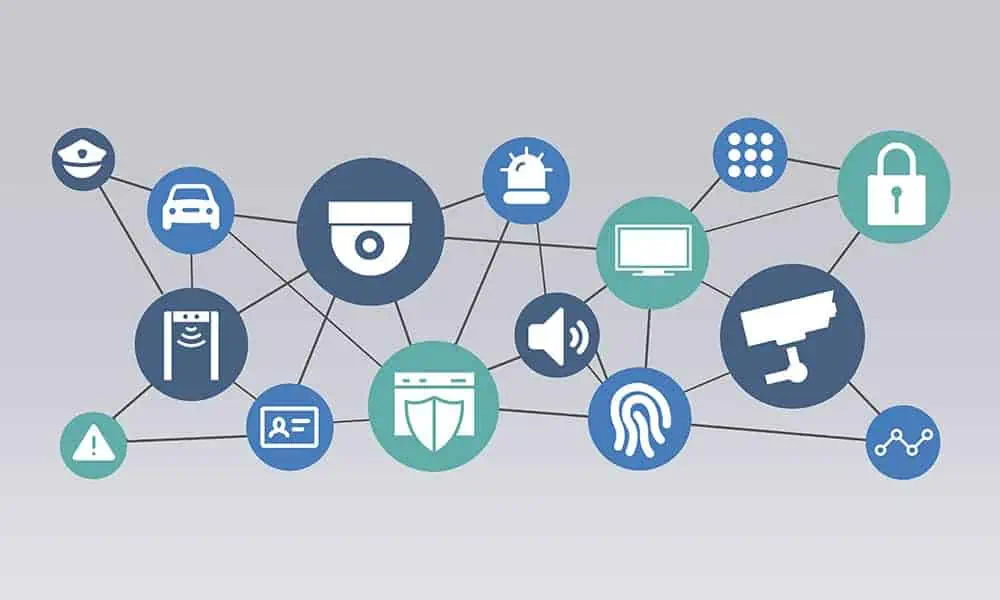Physical security measures can include a combination of access control locks, alarms, surveillance cameras, lighting systems and other security measures. It’s important for businesses because advanced security can protect businesses from financial losses due to theft, misuse, or vandalism, as well as potential damage to your reputation. It also helps ensure that employees are safe and secure at work.

Why is Physical Security Important?
Physical security is vital for protecting people, property, and assets from potential harm or loss. It acts as the first line of defense against threats like theft, vandalism, unauthorized access, and natural disasters. Robust physical security measures, such as surveillance systems, access controls, and trained personnel, deter criminals and minimize the risk of incidents. Additionally, physical security fosters a sense of safety and well-being, enabling individuals and organizations to operate efficiently without constant worry.
Beyond protecting physical assets, physical security also safeguards digital infrastructure. In today’s interconnected world, data centers and server rooms house sensitive information. Implementing physical security measures like fire suppression systems, climate control, and restricted access protects critical data from breaches and ensures business continuity. A comprehensive approach to security encompasses both physical and digital aspects, creating a resilient and protected environment.
Types of Physical Security
Cloud-Based Access Control
This type of access control relies on cloud-based technology to allow users to enter certain restricted areas. For example, a building owner may give specific employees access to parts of the office based on their role in the company. This type of activity can be achieved without the need of information technology assets or trained personnel on-premises.
Digital Security Control
This type of access control includes two-factor authentication, biometrics, on-premise systems, and up-to-date hardware.
Physical Security Control
This type of access control includes physical barriers, video surveillance, mobile credentials, and intrusion detection systems.
These are just some examples of the different types of physical security solutions available. However, physical security controls can be broken down further.

Physical security measures and method
There are all kinds of physical security measures, but the main types of physical security fall into four broad categories: Deter, Detect, Delay and Respond.
Deter – Deterrence physical security measures are focused on keeping intruders out of the secured area. Common methods include tall perimeter fences, barbed wire, clear signs stating that the site has active security, commercial video cameras and access controls. All of these are designed to give a clear message to criminals that trespassing is not only difficult, it is also highly likely that they will be caught.
Detect – Detection works to catch any intruders if they manage to get past the deterrence measures mentioned above. Some criminals might slip in behind an employee — known as tailgating — or they might find a way of scaling barriers. In these cases, a physical security measure that can detect their presence quickly is crucial.
Delay – You will notice that several physical security systems have multiple roles: they can deter as well as detect. Many of the physical security measures above also effectively delay intruders. Access control systems require credentials to open a locked door, slowing an intruder down and making it easier to apprehend them.
Respond – Having the technology and processes to respond to intruders and take action is crucial for physical security, yet often overlooked. Response physical security measures include communication systems, security guards, designated first responders and processes for locking down a site and alerting law enforcement.
Physical Security Advantages
there are many facilities provided for physical security with a good amount of advantages. First is perimeter security that includes mantrap, fences, electric fences, gates and turnstile. Safe locks with keys that are hard to duplicate. Badges are necessary for verifying the identity of any employee. Set up the surveillance and at places that won’t expose it or let the attacker tamper with it. Safeguard any vulnerable device and protect the portables.
The great advantage is that criminals or attackers have to bypass through many layers of security to gain their objective. As a result, it gets harder for them to accomplish their mission. There are many methods and equipment that is difficult to scale by an intruder, has a low budget to set it and reduces security threat.
Physical security control technology
Within the four main types of physical security control categories is an enormous range of physical security tools and cutting-edge technology.
Physical security technologies have evolved in leaps and bounds in recent years, offering advanced protection at accessible price points. Physical security devices now use cloud technology and artificial intelligence for even smarter processing in real time.
Automated physical security components can perform a number of different functions in your overall physical security system. For physical controls, you might want to verify entry and exits with access control technology. You can carry out proactive intrusion detection with video security and access controls that work together as a unified system.
Video security
Video surveillance technology is a core element of many physical security plans today. CCTV has moved on significantly from the days of recording analog signal to tape. So too has internet connectivity – thanks to fast network connections and the cloud, transmitting high-quality video is faster than ever before.
Video security is primarily a Detect form of physical security control. Using a live connection and smart cameras, it is possible to spot suspicious activity in real time. They can also be used to Deter intruders, since the sight of cameras around a premises can discourage criminals from attempting to break in.
Access control
Access control technology is another cornerstone of physical security systems. Like video security, access control systems give you an overview of who is entering and exiting your premises. It also gives you physical controls to keep certain people out and authorize people to enter. Access control systems can help Detect and Delay intruders from entering. They can also Deter intruders by making it too difficult to attempt entry. As with security cameras, there are many different types of access control devices.
Analytics and artificial intelligence
Physical security technologies can log large quantities of data around the clock. Now, this information can be enhanced with smart analytics. Analytics powered by artificial intelligence (AI) can process all this data and provide helpful digests for your security team, saving them valuable time and helping them to make faster, better informed decisions. Many types of physical security technology now have AI analytics included as part of their core functionality; however there are many options available on the market for a more tailored setup.
Sensor technology
Sensor technology is another Detect form of physical security and a key element in your security setup. These smart building devices detect environmental changes and alert security teams to potential threats. The most commonly used type of sensor is a smoke alarm, which helps to indicate a fire. Other sensors detect and observe motion, sounds, light, vaping, temperature and more.
Upon detecting vape, loud noises, unusual motion or other triggers, the sensor will notify the operator and enable the security team to respond quickly. When integrated with the wider physical security setup, the operator can use their security cameras to gain greater visibility of the incident and initiate a lockdown via the access control system, if necessary.
Common threats to physical security
In the digital era we live in, the number of threats is alarmingly increasing, with many now originating from cyberspace. From data breaches to hacking, the focus of many organizations has shifted, with greater focus on security solutions for physical security that also protect digital provisions.
Internal threats
This type of physical security threat comes from within your organization. Internal physical security risks are more challenging to contain than external threats as they are tougher to predict. They can be accidental or malicious in nature. Examples of such risks include:
- Employees committing theft or causing property damage
- Careless staff members leaving restricted areas open
- Mistakes made by your security team
- Faulty infrastructure or hazardous work conditions
External threats
As its name implies, this type of threat originates from outside your organization. This can include attacks from outside parties with malicious intent and natural disasters. External physical security threats can also include:
- Forced entry or break-ins
- Vandalism and property damage
- Unauthorized entry for persons outside your staff or approved visitor list
Natural threats
These physical security threats constitute damage caused by natural causes like floods, earthquakes, lightning strikes and other unpredictable natural disasters. In this situation, the physical security risk lies in the fact that such an event can cause extreme damage to your assets and endanger employees.
More than the loss of hardware, the loss of years and years of critical business data and investment, as well as injuries to your employees can have a severe blow to your business operation.
Emerging threats
In recent years, a series of emerging threats have paralyzed businesses and organizations and significantly affected their finances, customers and employees. Having been unknown or with few known occurrences in the past, these threats have now drawn the attention of businesses of all sizes. These emerging threats include:
- Cybersecurity attacks that bring operations to a standstill.
- Increased prevalence of vaping, particularly among students at school.
- The spread of infectious diseases can severely impact people’s health.
- Increase in violent behavior and acts of aggression.

Physical security planning
Physical security planning is the process of safeguarding people, property, and information from physical threats. It involves a comprehensive assessment of potential risks and implementing measures to deter, detect, delay, and respond to incidents.
Key Components of a Physical Security Plan
A robust physical security plan typically includes the following elements:
Risk Assessment
- Identify assets: Determine what needs protection (people, property, information).
- Assess threats: Evaluate potential hazards (natural disasters, theft, vandalism, terrorism).
- Analyze vulnerabilities: Identify weaknesses in your security infrastructure.
Security Controls
- Access control: Implement measures to restrict entry to authorized personnel (ID cards, locks, biometrics).
- Surveillance: Install CCTV cameras, alarms, and motion detectors.
- Perimeter security: Use fences, gates, and lighting to deter intruders.
- Emergency procedures: Develop plans for evacuations, fire safety, and other emergencies.
- Personnel security: Conduct background checks, implement security awareness training.
Technology Integration
- Access control systems: Utilize electronic locks, card readers, and biometric authentication.
- Video surveillance: Employ high-definition cameras with advanced analytics.
- Intrusion detection systems: Install sensors and alarms to detect unauthorized entry.
- Security management software: Manage and analyze security data efficiently.
Incident Response
- Develop response plans: Outline procedures for handling security incidents.
- Train personnel: Conduct regular drills and simulations.
- Collaborate with law enforcement: Establish relationships with local authorities

Physical security best practices
Investing in security personnel
One of the best deterrents against possible attacks is visible security, and this is what investing in security personnel can guarantee. For example, you can hire extra security guards or change the existing patrol routes to cover more ground. Consider manning important entrances and exits, which can help ensure that no unauthorized entries or exits happen.
On top of that, having security personnel can give your employees peace of mind and dissuade those with malicious intent from working against your business. However, having security guards doesn’t automatically guarantee protection and safety.
Using monitoring systems
Security guards can be effective in deterring and delaying intruders, but they can only detect threats within their proximity. This is where monitoring systems come into play. This type of physical security system can help you know what’s happening in various areas of your facilities at the same time while preventing potential dangers. However, not all monitoring solutions are right for every property, and many factors contribute to their effectiveness.
Implementing sensors
Implementing smart sensors like the HALO Smart Sensor into your physical security strategies can deliver greater situational awareness for your security team. This enables your team to receive instant sensor alerts to security incidents, leading to faster analysis and responses to help extinguish the threat.
Educating your employees
To guarantee that your employees are prepared, make sure that they are well-trained to handle physical security threats. When they know the standard operating procedure, they can contribute to protecting your assets, and can maybe even save lives in the process. At the same time, educating them can give them peace of mind that they are protected when breaches and emergencies occur.
physical security challenges
Budget shortages prevent many businesses from making an appropriate physical security investment. However, failing to budget for an adequate physical security system can lead to physical security failures over time. Some physical security measures can strain a budget more than others; for example, hiring security guards can be costly, especially if many are needed to guard a site for long periods of time.
Staff shortages can also put pressure on physical security systems. Even with the most advanced physical security technology in place, businesses still need personnel to oversee larger systems and make decisions about how and when to take action. In the wake of the coronavirus pandemic, many businesses suffered from recruitment shortages. Not having enough people to implement your physical security plan can put a strain on morale and cause operational issues.
Physical security technology enhances business security, but if it is not properly integrated into a larger physical security system, it can bring problems rather than benefits. A key factor to bear in mind is how your physical security devices interface, and how they feed information back into your physical security system. If your devices are not compatible, or they are not properly integrated, critical information might be missed. One way to minimize the likelihood of this happening is to use devices that comply with ONVIF camera physical security standards.
physical security implementation
Perimeter security
This is one of the most common physical security examples we see today. Perimeter security is straightforward. It involves creating physical barriers that protect your facility from intruders. This includes fences, gates, barbed wire and security guards. This type of physical security is also your first line of defense to deter intruders from getting into your facility.
Environmental elements
The layout and landscaping on your property can help control the flow of traffic on the premises, and deter unwanted activity. For example, high hedges around the perimeter, motion-activated lighting and maintained walking paths make it easier to spot anyone who looks suspicious lurking around the building exterior.
Secure credentials for authorized individuals
Requiring every authorized individual to have access credentials is among the top security best practices to implement in your building. There are many types of systems, and each can be used depending on the threat level or importance of an area, including:
- Key cards / ID badges
- Key fob door entry system
- Biometric readers
- Keypad locks
- Mobile-based credentials
Restricted access areas
This physical security example shows how measures can be implemented for restricted areas, such as a server room or area with expensive equipment. Areas like this can only be accessed by a small subset of the staff, which requires additional access credentials, such as MFA, unique PINs or biometric credentials. If anything goes missing or is damaged in the room, it narrows down who can be held accountable.
Logs and audit trails
Another way to secure a facility is through detailed logging. Instead of just limiting access, this physical security method keeps a record of which credentials are used, as well as where and when the activity occurred. This doesn’t only deter unauthorized users, but also allows you to create a forensic-friendly data environment essential for physical security management and maintenance.
Monitoring systems
Most organizations have surveillance in place to protect a facility. This allows them to detect intruders right away that may have bypassed other security measures, like perimeter security. Some systems can also detect natural disasters and issue warnings if they do. These systems can include motion detectors, security cameras and fire alarms. In some situations, having these devices record activities is enough.
Conclusion
Physical security is the cornerstone of comprehensive protection for people, property, and information. While technological advancements have reshaped many aspects of security, the fundamental need for physical safeguards remains paramount.
By implementing a well-structured physical security plan, organizations and individuals can significantly reduce the risk of threats such as theft, vandalism, unauthorized access, and natural disasters. It is essential to recognize that physical security is an ongoing process that requires continuous evaluation, adaptation, and investment.
A proactive approach to physical security fosters a safe and secure environment, enhancing productivity, protecting assets, and building trust. It is not merely a cost but a strategic investment in the overall well-being of an organization or community.
physical security is an indispensable component of holistic risk management. By prioritizing this critical aspect of protection, we can create a safer and more resilient world.
FAQs
Security experts agree that the three most important components of a physical security plan are access control, surveillance, and security testing, which work together to make your space more secure.
Physical security involves measures designed to safeguard personnel, assets, and information against unauthorised access, damage, or theft. Unlike its digital counterpart, it operates in the physical realm, encompassing a spectrum of strategies aimed at creating secure environments.
Unauthorized Access via Credential Theft One common weakness lies in the theft or cloning of access credentials, such as keycards or PIN codes, allowing unauthorized individuals to gain entry.
